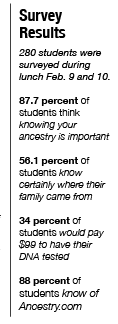Discovering family roots
Heritage revealed through DNA test
April 12, 2018
When junior Morganna Oberdorfer’s friends bought her a 23andMe DNA kit, she said she was excited for all the answers about her ancestry to be revealed.
“I talked about (my heritage) a lot when people asked me what ‘I am’ and I never really completely had an answer,” Oberdorfer said.
Oberdorfer said she hoped to learn more about the biological traits her family passed down to her.
“I don’t know all of my family members and where they all came from, so I didn’t know where I came from,” Oberdorfer said. “I wanted to know where my dark hair came from, and why I tan instead of sunburn and things like that.”
According to biology teacher Julie Schilz, while accessibility of the DNA testing is convenient, customers should be aware there are still potential inaccuracies in the results.
“I think it’s really cool (to) have it be more accessible. But I think with that accessibility it should be made clear to consumers the discrepancies in the results, or if they’re super accurate, as well as what the results mean and how to interpret them,” Schilz said.
Schilz said DNA testing doesn’t have an educational benefit.
“I think it is more of a thing for fun, to be able to imagine that six generations ago your ancestors (lived) in a certain part of the world. Other than that, for me at least, I don’t see a biological point to it,” Schilz said.
According to the 23andMe website, they now work alongside Ancestry.com to provide DNA results for customers interested in their lineage. 23andMe uses DNA, while other companies help find lineage using physical records like birth and marriage certificates.
According to Schilz, 23andMe finds each customer’s ancestry by assessing how sections of DNA compare to DNA in other geographic locations already in their databases.
“They’re comparing your DNA to other people that are in their system, so it’s not the end of the story. It’s not whatever they categorize you as. It just happens to be what your DNA bases align most with,” Schilz said. “You could genetically be similar to someone from one part of the world and also have your bases be similar to someone else in another part of the world.”
According to the 23andMe website, its already extensive DNA database, with more than 3 million customers, continuously expands as its business grows.
Junior Delaney Wallerich said she plans to participate in DNA ancestry testing. She said while heritage is important, it should not alter the way she views herself.
“Your heritage does not shape you as a person. It won’t change the way I feel about myself,” Wallerich said.
Schilz said she feels individuals can misinterpret their results and make inconsiderate remarks.
“For your average person being able to go and spent (money) on an ancestry test and have the results come back and be like ‘hey look I’m 3 percent African so I’m just like you’ to somebody who can clearly trace their lineage back. I think insensitive comments like that can be an issue,” Schilz said.
Oberdorfer said heritage impacts how people view each other.
“It is part of your identity, and it’s how the world sees you, the kind of stuff you do and the way you see the world. It makes everybody different,” Oberdorfer said.
Junior Lexi Lee said she and her siblings had their DNA tested by Ancestry. According to Lee, family tradition remains important and should continue regardless of DNA results.
“Traditions are all about bringing people together, so even if you don’t come from (a specific heritage) it can still connect you with people,” Lee said.
Wallerich said she wants to test her DNA because she is curious about discovering her roots.
“I have always been curious (about) where my ancestors came from. I just thought it would be a good opportunity to discover about myself and answer the question of where I come from,” Wallerich said.
Lee said there were no surprises when she and her siblings found out the results.
“The main (results) were what we already knew, like Norway and Germany, so mostly European countries,” Lee said.
According to Oberdorfer, she was shocked when she saw her results.
“I had always been told my grandma was 100 percent Irish, but the results said I was only 8 percent. I should have been 25 percent,” Oberdorfer said.
Lee said her family got their DNA tested by Ancestry because her family had been previously tracking their heritage through the website.
“When we were younger, my parents got an Ancestry account, so we trace our ancestry far back. We were already familiar with the company,” Lee said.
Lee said completing the kit was fairly easy and cheap when splitting the cost between people.
“It was easy to do, but you need a lot of spit,” Lee said. “We split the cost between the three of us, my siblings, so it wasn’t as much as it would be for just one person.”
According to the Ancestry website, the DNA testing kits normally cost $99 and can take six weeks or more to receive the results. The kits can be bought on the Ancestry or 23andMe websites.
Officials at Ancestry declined to comment.


